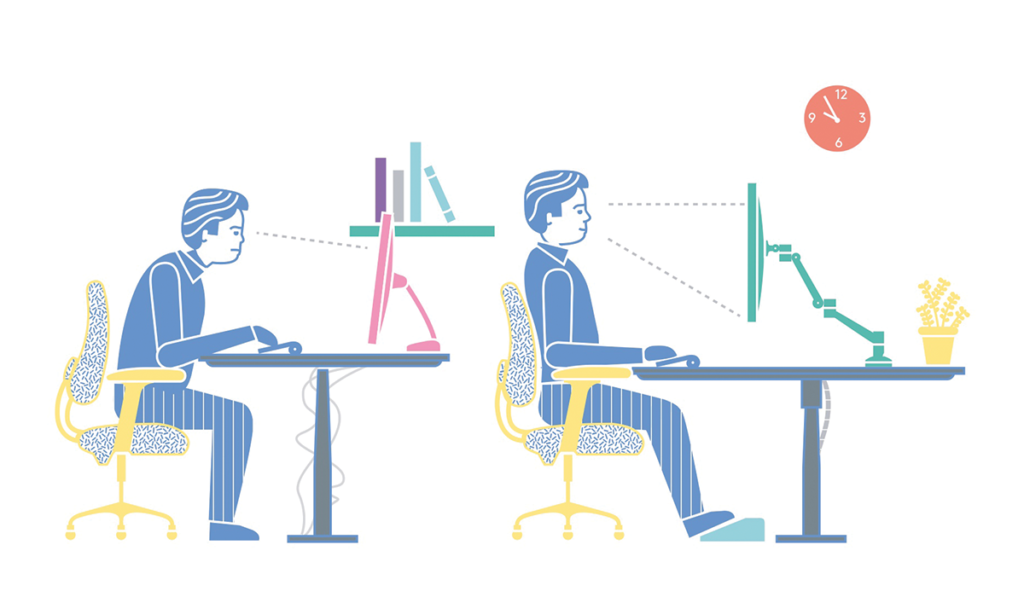
Over the past several months, countless employees have transitioned from working in an office to working from home. For many, this shift has highlighted a common pitfall of remote work: a lack of proper desks, chairs and other equipment like they had at the office. Without an ergonomically sound space where employees can work comfortably, safely and productively at home, they may find themselves spending long hours sitting in awkward positions, such as slouched over a kitchen table or on the couch. These scenarios can cause discomfort and, eventually, lead to musculoskeletal disorders (MSDs), which encompass some of the most common work-related injuries and are a leading driver of healthcare costs for businesses.
Considering that the most valuable asset of any business is its workforce, employers have a clear interest in enhancing employees’ safety and comfort. Helping those who are working from home improve the ergonomics of their workspaces may offer the following benefits that directly impact an organization’s bottom line:
- Greater employee wellness. Employees who are free of discomfort and injury are able to perform optimally.
- Improved productivity. Generally, working from home is conducive to greater productivity since employees save a significant amount of time by not having to commute. However, these gains in productivity can quickly be erased if employees begin needing to take time off work due to discomfort or injuries caused by an improper workstation setup. By taking a proactive approach to preventing MSDs in work-from-home employees, businesses can maximize the productivity of their workforces.
- Containment of healthcare and workers’ compensation costs. When employees develop MSDs, their employers may bear the burden of medical expenses, rising healthcare premiums, and workers’ compensation claims.
- Increased employee retention. Helping employees create comfortable work environments can boost workforce morale, thereby improving retention. Additionally, by taking steps to prevent injuries, employers can avoid the costs and effort of having to replace employees who are unable to continue their job duties.
For businesses managing a remote workforce, promoting sound ergonomic practices for work-from-home employees can be the key to reducing the risk of MSDs. Here are a few steps that may help improve employee comfort and prevent injuries:
- Assist employees with setting up proper workstations in their home offices. This may include purchasing items such as desk chairs, mouse devices, keyboards or laptop stands. When considering what to buy, employers should keep in mind that just because a product is marketed as “ergonomic” does not mean it will enhance comfort for all users. Most office equipment is not a one-size-fits-all solution, but there are vendors that offer a free trial period that allows employees to see how an item suits their unique needs and body type before making a purchase.
- Invest in online ergonomics training that explains proper posture, workstation setup and how employees can empower themselves to stay safe and comfortable regardless of where they are working.
- Consult an ergonomics professional. Ensuring safe and comfortable workstations is more complex when dealing with a remote workforce, as everyone has different equipment and space available. A professional ergonomics consultant can provide customized solutions for individual employees, including product recommendations, suggestions for how to modify existing workstations, and tips for stretching and managing stress.
Whether businesses are considering remote work as a permanent option or are planning to have their teams return to the office when it is safe to do so, managing employees who are working from home presents an array of challenges, including the heightened risk of MSDs. By taking a proactive approach to helping employees work more safely and comfortably wherever they are, businesses can reduce their costs while creating a healthier, happier, and more productive workforce.
Merl Miller is the owner of Performance Ergonomics, which, since 2005, has been helping businesses prevent workplace injuries through comprehensive ergonomic solutions, providing office assessments, ergonomics training, custom product recommendations and more.


















